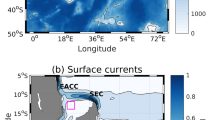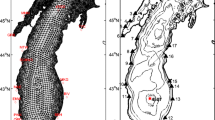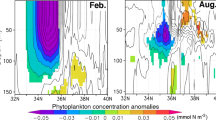Abstract
A vertical one-dimensional physical–biological model is applied to clarify the mechanisms controlling the seasonality and interannual variability of primary production in the surface layer at two contrasting time-series stations, K2 (in the subarctic gyre) and S1 (in the subtropical gyre), in the western North Pacific. Using forcing based on realistic atmospheric and oceanic data, the model reproduces seasonal differences in the degree to which different controlling factors affect primary production between these two stations, primarily as a result of differences in the physical environment. At station K2, light intensity is an important factor controlling primary production in summer. After April, the mixed layer depth (MLD) becomes shallow, resulting in higher average light intensity, and the water column remains stratified until September; these sustain high primary production during this period. In contrast, at station S1, the supply of nutrients via entrainment is vital to sustaining production, because light intensity remains sufficient throughout the year. In summer, the relationship between nutricline depth and euphotic layer is a controlling factor. The simulations forced by the different atmospheric conditions for each year, respectively, show different MLD. In the 2012 simulation, the deep winter MLD (200 m) enhances primary production in the surface layer as compared to the other two years (2010 and 2011) simulations.









Similar content being viewed by others
References
Antonov JI et al (2010) World Ocean Atlas 2009, vol 2: salinity. S. Levitus, Ed. NOAA Atlas NESDIS 69. US Government Printing Office, Washington, DC, pp 184
Behrenfeld MJ, Falkowski PG (1997) Photosynthetic rates derived from satellite-based chlorophyll concentration. Limnol Oceanogr 42:1–20
Boyd PW et al (2010) Remineralization of upper ocean particles: implications for iron biogeochemistry. Limnol Oceanogr 55(3):1271–1288. doi:10.4319/lo.2010.55.3.1271
Boyd PW, Ellwood MJ (2010) The biogeochemical cycle of iron in the ocean. Nat Geosci. doi:10.1038/NGO964
Buesseler KO et al (2007) Revisiting carbon flux through the oceans twilight zone. Science 316:567–570
Denman KL et al (2006) Modelling the ecosystem response to iron fertilization in the subarctic NE Pacific: the influence of grazing, and Si and N cycling on CO2 drawdown. Deep Sea Res II 53:2327–2352
Denman KL, Peña MA (1999) A coupled 1-D biological/ physical model of the Northeast Subarctic Pacific Ocean with iron limitation. Deep Sea Res II 46:2877–2908
Fujii M et al (2002) A one-dimensional ecosystem model applied to time-series Station KNOT. Deep Sea Res II 49:5441–5461
Fujiki T et al (2014) Seasonal cycle of phytoplankton community structure and photophysiological state in the western subarctic gyre of the North Pacific. Limnol Oceanogr 59(3):887–900. doi:10.4319/lo.2014.59.3.0887
Garcia HE et al. (2010) World Ocean Atlas 2009, vol 4: nutrients (phosphate, nitrate, silicate). S. Levitus, Ed. NOAA Atlas NESDIS 71. US Government Printing Office, Washington, DC, pp 398
Goes JI et al (2004) A comparison of the seasonality and interannual variability of phytoplankton biomass and production in the western and eastern gyres of subarctic Pacific using multi-sensor satellite data. J Oceanogr 60:75–91
Harrison PJ et al (2004) Nutrient and plankton dynamics in the NE and NW gyres of the subarctic Pacific Ocean. J Oceanogr 60:93–117. doi:10.1023/B:JOCE.0000038321.57391.2a
Honda MC et al (2016a) Overview of Study of change in ecosystem and material cycles by the climate change based on time-series observation in the western North Pacific: K2S1 project (this volume, a)
Honda MC et al (2016b) A comparison of fluxes and characteristics of sinking particles in mesopelagic / bathypelagic layer between subarctic station K2 and subtropical station S1 based on moored time-series sediment trap experiment (this volume)
Honda MC et al (2002) The biological pump in the northwestern North Pacific based on fluxes and major components of particulate matter obtained by sediment trap experiments (1997–2000). Deep Sea Res II 49:5595–5625
Honda MC et al (2006) Quick transport of primary production organic carbon to the ocean interior. Geophys Res Lett 33:L16603. doi:10.1029/2006GL026466
Honda MC et al (2015) Comparison of sinking particles in the upper 200 m between subarctic station K2 and subtropical station S1 based on drifting sediment trap experiments. J Oceanogr. doi:10.1007/s10872-015-0280-x
Honda MC, Watanabe S (2010) Importance of biogenic opal as ballast of particulate organic carbon (POC) transport and existence of mineral ballast-associated and residual POC in the Western Pacific Subarctic Gyre. Geophys Res Lett 37:L02605. doi:10.1029/2009GL041521
Kawakami H et al (2014) Time-series observations of \({}^{210}\)Po and \({}^{210}\)Pb radioactivity in the western North Pacific. J Radioanal Nucl Chem 301:461–468. doi:10.1007/s10967-014-3141-y
Kawakami H, Honda MC (2007) Time-series observation of POC fluxes estimated from \({}^{234}\)Th in the northwestern North Pacific. Deep Sea Res I 54(7):1070–1090
Kawamiya M et al (1997) Procuring reasonable results in different oceanic regimes with the same ecological–physical coupled model. J Oceanogr 53:397–402
Kishi MJ et al (2007) NEMURO: a lower trophic level model for the North Pacific marine ecosystem. Ecol Model 202:12–25
Kouketsu S et al (2015) Mesoscale eddy effects on temporal variability of surface chlorophyll a in the Kuroshio Extension. J Oceanogr. doi:10.1007/s10872-015-0286-4
Locarnini RA et al (2010) World Ocean Atlas 2009, vol 1: temperature. S. Levitus, Ed. NOAA Atlas NESDIS 68. US Government Printing Office, Washington, DC, pp 184
Martin J et al (1994) Testing the iron hypothesis in ecosystem of the equatorial Pacific Ocean. Nature 5:1–13
Matsumoto K et al (2016) Primary productivity at the time-series stations in the northwestern Pacific Ocean: Is the subtropical station unproductive? (this volume)
Matsumoto K et al (2014) Seasonal variability of primary production and phytoplankton biomass in the western Pacific subarctic gyre. Control by light availability within the mixed layer. J Geophys Res Ocean 119:6523–6534. doi:10.1002/2014JC009982
Mellor GL, Yamada T (1982) Development of a turbulence closure model for geophysical fluid problems. Rev Geophys Space Phys 20:851–875
Moore JK, Doney SC, Lindsay K (2004) Upper ocean ecosystem dynamics and iron cycling in a global three-dimensional model. Glob Biogeochem Cycles 18:GB4028. doi:10.1029/2004GB00220
Onogi K et al (2007) The JRA-25 reanalysis. J Meteorol Soc Jpn 85:369–432. doi:10.2151/jmsj.85.369
Pahlow M (2005) Linking chlorophyll-nutrient dynamics to the Redfield N:C ratio with a model of optimal phytoplankton growth. Ecol Prog Ser 287:33–43. doi:10.3354/meps287033
Parekh P, Follows MJ, Boyle E (2002) Modeling the global ocean iron cycle. Glob Biogeochem Cycles 18:GB1002. doi:10.1029/2003GB002061
Sarmiento JL et al (1993) A seasonal three-dimensional ecosystem model of nitrogen cycling in the North Atlantic euphotic zone. Glob Biogeochem Cycles 7:417–450
Sasai Y et al (2010) Effects of cyclonic eddies on the marine ecosystem in the Kuroshio Extension region using an eddy-resolving coupled physical–biological model. Ocean Dyn 60(3):693–704. doi:10.1007/s10236-010-0264-8
Sasaoka K et al (2002) Temporal and spatial variability of chlorophyll-a in the western subarctic Pacific determined from satellite and ship observations from 1997 to 1999. Deep Sea Res II 49:5557–5576
Shigemitsu M et al (2012) Development of a one-dimensional ecosystem model including the iron cycle applied to the Oyashio region, western subarctic Pacific. J Geophys Res 117:C06021. doi:10.1029/2011JC007689
Siswanto E et al (2014) Reappraisal of meridional differences of factors controlling phytoplankton biomass and initial increase preceding seasonal bloom in the northwestern Pacific Ocean. Remote Sens Environ 159:44–56. doi:10.1016/j.rse.2014.11.028
Smith SL et al (2009) Optimal uptake kinetics: physiological acclimation explains the observed pattern of nitrate uptake by phytoplankton in the ocean. Mar Ecol Prog Ser 384:1–12. doi:10.3354/meps08022
Smith SL, Yoshie N, Yamanaka Y (2010) Physiological acclimation by phytoplankton explains observed changes in Si and N uptake rates during the SERIES iron-enrichment experiment. Deep Sea Res I 57:394–408. doi:10.1016/j.dsr.2009.09.009
Steel JH (1962) Environmental control to phytoplankton in sea. Limnol Oceanogr 7:137–172
Takeda S et al (2006) Modeling studies investigating the causes of preferential depletion of silicic acid relative to nitrate during SERIES: a mesoscale iron-enrichment in the NE subarctic Pacific. Deep Sea Res II 53:2297–2326
Tsuda A et al (2003) A mesoscale iron enrichment in the western subarctic Pacific induces large centric diatom bloom. Science 300:958–961. doi:10.1126/science.1082000
Wakita M et al (2016) Biological organic carbon export estimated from annual carbon budget in the surface water of western subarctic and subtropical North Pacific Ocean (this volume)
Yoshikawa C, Yamanaka Y, Nakatsuka T (2005) An ecosystem model including nitrogen isotopes: perspectives on a study of the marine nitrogen cycle. J Oceanogr 61:921–942
Acknowledgments
This work was partially supported by a CREST project (PI SLS) funded by the Japan Science and Technology Agency. We are also grateful to anonymous reviewers for their constructive and valuable comments.
Author information
Authors and Affiliations
Corresponding author
Appendix: Ecosystem model
Appendix: Ecosystem model
The simple nitrogen- and silicon-based plankton ecosystem model, consisting of nine compartments, is coupled with a 1-D physical model of the oceanic mixed layer. The compartments (biological tracers) are nitrate (NO\({}_{3}\)), ammonium (NH\({}_{4}\)), silicate (Si), two categories of phytoplankton (small phytoplankton, PS and large phytoplankton, PL), zooplankton (Z), dissolved organic nitrogen (DON), particulate organic nitrogen (PON), and bio-silicate (BSi is opal). The evolution of each biological tracer concentration is determined by vertical diffusive mixing using the diffusivity as calculated by the mixed layer model (Mellor and Yamada 1982), and biogeochemical source-minus-sink (sms) terms. The sms terms resulting from biological activity are shown in Fig. 3. Their equations for each individual biological tracer (NO\({}_{3}\), NH\({}_{4}\), Si, PS, PL, Z, DON, PON, and BSi) are:
where superscript number (1–25) of biological tracer flux term in each equation is corresponding to biological tracer flux number of Fig. 3. GppPS and GppPL are the absolute values of growth rate (gross primary production), as a function of phytoplankton concentration, depth z, time t, nutrient concentration, N and light intensity. Growth rate depends exponentially on temperature, T, via the so-called Q10 relation, and the light limitation follows Steel (1962). Growth rate depends on nutrient concentrations via Optimal Uptake (OU) kinetics (Pahlow 2005; Smith 2009) as applied, assuming fixed composition of phytoplankton (Shigemitsu 2012). By accounting for physiological acclimation to different nutrient concentrations, OU kinetics has been shown to give a different response under changing environmental conditions, compared to the more widely applied Michaelis-Menten/Monod (MM) equation (Smith 2009; Smith et al. 2010). This results in a saturating dependence of growth rate on nutrient concentration, as for the MM equation, but with a slightly different shape expressed by the following equations:
where \({I}_{0}\) is light intensity at the sea surface, and T is water temperature. Small and large phytoplankton (PS and PL in Eqs. 1, 2) are produced by their own growth, and reduced by respiration, mortality, extracellular excretion), and grazing by zooplankton. Grazing rate of phytoplankton by zooplankton is as follows:
Zooplankton (Z in Eq. 3) depends on the grazing rate of Z, excretion rate of Z, egestion rate of Z, and mortality rate of Z. Particulate organic nitrogen (PON in Eq. 4) is produced by mortality (of PS, PL, and Z), and egestion by Z, and is consumed by its decomposition (to NH\({}_{4}\) and DON), and by sinking. Dissolved organic nitrogen (DON in Eq. 5) is produced by extracellular excretion (PS, PL) and decomposition (PON to DON), and is consumed by its remineralization (to NH\({}_{4}\)). Nitrate (NO\({}_{3}\) in Eq. 6) is consumed by the growth rate of phytoplankton (PS, PL), minus their respiration rate, and produced by nitrification (proportional to NH\({}_{4}\)). The f-ratio of phytoplankton (PS, PL) (no dimension) is defined by the ratio of NO\({}_{3}\) uptake to total N (NO\({}_{3}\) + NH\({}_{4}\)) uptake.
The source-sink terms for ammonium (NH\({}_{4}\) in Eq. 7) include the growth rate of phytoplankton (PS, PL), respiration rate (PS, PL), nitrification rate, decomposition rate (PON to NH\({}_{4}\), DON to NH\({}_{4}\)), and excretion rate (Z). Silicate Eq. (8) consumed by the growth of PL (diatoms) minus their respiration and excretion, and is consumed by its dissolution (to Si). Opal (BSi in Eq. 9) is produced by mortality of PL, egestion by Z, and is consumed by its decomposition to Si, and by sinking.
Rights and permissions
About this article
Cite this article
Sasai, Y., Yoshikawa, C., Smith, S.L. et al. Coupled 1-D physical–biological model study of phytoplankton production at two contrasting time-series stations in the western North Pacific. J Oceanogr 72, 509–526 (2016). https://doi.org/10.1007/s10872-015-0341-1
Received:
Revised:
Accepted:
Published:
Issue Date:
DOI: https://doi.org/10.1007/s10872-015-0341-1




